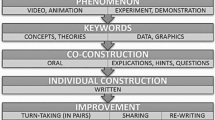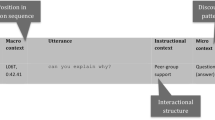Abstract
This study examined preservice teachers’ understanding of the syntactic structures of inquiry; in particular, what it means to give priority to evidence and how to use evidence to construct explanations. Data were collected from student journals, the course syllabus, the assignment description, and weekly lesson plans. The use of content analysis methods resulted in three assertions: (1) the students relied mainly on their sense of sight and not on all senses to make observations; (2) they had difficulties giving priority to the evidence gathered to formulate explanations; and (3) they needed multiple opportunities in class to explicitly discuss and reflect on their understandings. This study has implications for teaching elementary science methods and for teacher educators interested in conducting self-study research.
Similar content being viewed by others
References
Abell, S. K. (2007). Research on science teacher knowledge. In S. K. Abell & N. G. Lederman (Eds.),Handbook of research on science education (pp. 807–830). Oxford, UK: Taylor & Francis.
Abell, S. K., Anderson, G., & Chezem, J. (2000). Science as argument and explanation: Inquiring into concepts of sound in third grade. In J. Minstrell & E. van Zee (Eds.),Inquiring into inquiry learning and teaching in science (pp. 65–79). Washington, DC: American Association for the Advancement of Science.
American Association for the Advancement of Science (AAAS) (1993).Benchmarks for science literacy. New York: Oxford University Press.
Anderson, R. D. (2007). Inquiry as an organizing theme for science curricula. In S. K. Abell & N. G. Lederman (Eds.),Handbook of research on science education (pp. 807–830). Oxford, UK: Taylor & Francis.
Avraamidou, L., & Zembal-Saul, C. (2005). Giving priority to evidence in science teaching: A first-year elementary teacher’s specialized practices and knowledge.Journal of Research in Science Teaching, 42, 965–986.
Bransford, J. D., & Donovan, M. S. (Eds.). (2005).How students learn: Science in the classroom. Washington, DC: The National Academies Press.
Duschl, R. A., & Osborne, J. (2002). Supporting and promoting argumentation discourse in science education.Studies in Science Education, 38, 39–72.
Ferrance, E. (2000).Themes in education: Action research. Providence, RI: LAB of the Education Alliance at Brown University.
Gagnon, M. J., & Abell, S. K. (2008). Perspectives: Explaining science.Science and Children, 45(5), 60–61.
Kawasaki, K., Herrenkohl, L. R., & Yeary, S. A. (2004). Theory building and modeling in a sinking and floating unit: A case study of third- and fourth-grade students’ developing epistemologies of science.International Journal of Science Education, 26, 1299–1324.
Loughran, J. (2007). Researching teacher education practices; Responding to the challenges, demands, and expectations of self-study.Journal of Teacher Education, 58, 12–20.
National Research Council (NRC). (1996).National Science Education Standards. Washington, DC: National Academy Press.
NRC. (2000).Inquiry and the National Science Education Standards: A guide for teaching and learning. Washington, DC: National Academy Press.
Park Rogers, M. A. (2007, Spring).Life in a square assignment description. Unpublished course artifact.
Patton, M. Q. (2002).Qualitative research and evaluation methods (3rd ed.). Thousand Oaks, CA: Sage.
Russell, T. (1998). Part 1 introduction: Philosophical perspectives. In M. L. Hamilton (Ed.),Reconceptualizing teaching practices: Self-study in teacher education (pp. 5–6). Bristol, PA: Falmer Press, Taylor & Francis Inc.
Wu, K-K., & Hsieh, C-E. (2006). Developing sixth graders’ inquiry skills to construct explanations in inquiry-based learning environments.International Journal of Science Education, 28, 1289–1313.
Zeichner, K. (2001). Educational action research. In P. Reason & H. Bradbury (Eds.),Handbook of action research (pp. 273–284). Thousand Oaks, CA: Sage.
Zeichner, K. (2007). Accumulating knowledge across self-studies in teacher education.Journal of Teacher Education, 58, 36–46.
Author information
Authors and Affiliations
Corresponding author
Rights and permissions
About this article
Cite this article
Rogers, M.A.P. Elementary preservice teachers’ experience with inquiry: Connecting evidence to explanation. J Elem Sci Edu 21, 47–61 (2009). https://doi.org/10.1007/BF03174722
Accepted:
Issue Date:
DOI: https://doi.org/10.1007/BF03174722




